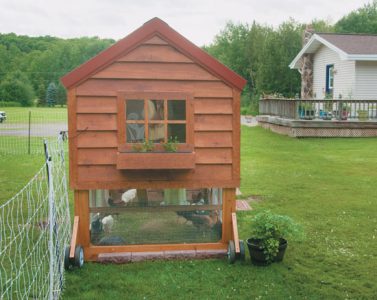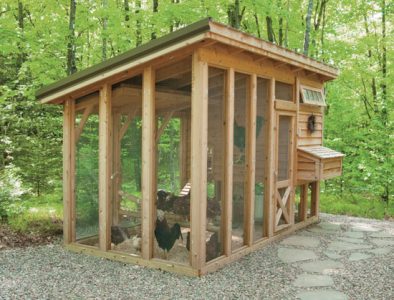Thinking about building a chicken coop yourself? Take these things into consideration before jumping right into the building process.
Before you gather up that scrap lumber and tie on your tool apron, you’ll want to consider a few things. Just where are you going to build this chicken coop? Have you thoroughly evaluated the available locations and chosen a site that will be the most effective place for your coop? Have you considered the presence of sun, shade, and wind? Have you considered legalities and ordinances that might be in effect? Have you figured some ballpark costs? Have you figured out where you’ll buy your chickens? And what breed(s) will you choose?
The best time to ask these questions is before you begin to build and before you start sketching plans or buying lumber. So try to establish a clear picture in your mind of exactly what your chicken coop project is going to entail. In this chapter, we’ll walk you through each of these steps so that you can proceed with your project confidently and with the knowledge that you’ve carefully considered your options and made smart decisions. Let’s get going!
Costs of Building a Chicken Coop
Okay, admit it, this is the question that you’re wondering about most of all. Just how much is this chicken coop going to cost, anyway? It’s a legitimate question, and one that is wise to consider before you begin building an elaborate chicken mansion that you later discover is far out of your price range. At the very least, you need a ballpark figure on which to build.

There’s only one thing: coming up with that ballpark figure isn’t necessarily easy. The number of variables involved with this type of project can make it difficult to establish a basic cost. What kind of variables, you ask? Here are a few:
- The price of lumber: This varies regionally, seasonally, and by type. Pine is generally cheaper; cedar is more expensive. The type of lumber you choose will have a direct and significant effect on the overall cost of your coop.
- Your skill level: Can you do most of the work yourself? Or will you need to hire someone to handle certain parts of the project? Do you have friends or relatives with the skills to help you construct your coop?
- The size of your coop and its design: Will you choose a metal roof? Or cedar shingles? Do you need a coop that is large enough to house a dozen hens, or will a four-hen coop suffice? Is the coop going to be moveable or stationary? Your choices of material and the finished size will have a direct impact on the cost of your coop.
- Existing materials and supplies: Do you have leftover scrap lumber from a previous project that you can repurpose for your chicken coop? Or will you have to invest in new lumber for the entire project?
- Existing tools: Is your garage already equipped with a chop saw and a compressor? How about a cordless drill? If you already have access to these vital tools, you’ll have fewer immediate expenses than someone who must go out and purchase tools before starting on the project. Or is it possible for you to borrow some of the more expensive tools from a family member or neighbor?
- Starting from scratch or repurposing another building: Perhaps you have a child’s playhouse that’s no longer being used, an extra shed on your property, or an old vehicle that no longer serves its original purpose. Or do you like the idea of designing and building your own coop? Starting with a preexisting building will definitely save some dollars, but it may limit some of your other design options.
So while one person might be able to build an entire coop for $600, someone else might build an identical coop at a cost of $1,000. Get out your pencil and paper, and maybe a calculator, and figure out what it might cost you before you begin building.
Choosing a Location for Your Chicken Coop
Having made the decision to build your own chicken coop, one of the first things to consider — and indeed, one of the most important things to consider — is where it should be built. There are many factors to consider when choosing the location for your chickens’ happy home. Making the right decision is very important for the wellbeing of your chickens, as well as to save you from unnecessary expenditures of time and effort. After all, you don’t want to go to all the trouble of building the world’s greatest chicken coop only to realize that a poor choice of location has introduced several unavoidable problems that will seriously hinder your quest to raise poultry. And as you will soon discover, once a chicken coop is fully constructed, transporting it to a different location is not always an easy task!

Of course, you could consider a mobile chicken coop, sometimes called a chicken tractor. If you have the room to move your coop from place to place on your property, this is an attractive option to consider. At this point we’re going to be discussing the coop as a permanent fixture and not a moveable coop; we’ll go into that possibility later on. To prevent yourself from traveling down blind alleys or embarking on wild goose (or chicken!) chases, you will want to devote a good deal of time to choosing the ideal location for your coop.
One of the first things to look for is the condition of the ground. It is not advisable to build your coop on a moist site, as wet conditions promote the development of mold. If your coop is made of untreated wood, moist ground can lead to the decay of your coop due to rot. Additionally, there are many health issues to consider, and a wet or damp site is not ideal for your chickens’ health. So be sure to choose a dry site that will remain free of standing water or general wetness, even after a heavy rain.
In examining ground conditions, you should also look for a level site without slopes (unless your coop is to feature a professionally built, level foundation) because building on a sloped surface will not only make caring for your chickens difficult, but it could introduce the possibility of the coop tipping over in the right circumstances. A slight slope can be corrected by propping up the low side of your coop with a sturdy foundation of concrete blocks, but if the slope seems too steep, you might want to choose a different place.
Separation Vs. Convenience: The Chicken Coop’s Great Debate
One of your primary considerations when choosing the location for your coop is whether you prefer the convenience of having the coop located close to your house or the aesthetic and aromatic benefits of having the coop located further away. If you live on a small lot, you may not have much choice, but if you live on a larger parcel, you will soon discover that choosing between separation and convenience is a multifaceted decision without a clear-cut answer.
There are obvious benefits and drawbacks to both possibilities. If you shudder at the thought of awakening every morning to the sight of a chicken coop right outside your door and if the meandering arrival of “fowl” odors every time you open your windows is not something you desire, then locating your coop farther away from your house could be a relief to you and your family. Then again, if occasional odors don’t bother you, and if the sight of your coop and your chickens gives you a sense of satisfaction and accomplishment, then positioning your coop closer to your house will allow you to reap the rewards that a more distantly placed coop cannot offer. We should mention, though, that a clean and well-maintained coop offers little odor, and an attractive coop can actually be a pleasant addition to your yard.
One of the primary benefits to keeping your coop near your home is its proximity to water and electricity. Obviously, the farther your coop is from a water source, the farther you will have to haul fresh water for your chickens — a chore that will need to be done frequently. Therefore, regardless of whether you locate your coop close to or far away from your house, you would not want to place it at the top of a steep hill, several hundred feet from the nearest water faucet. Even the most devoted chicken enthusiasts may find the trek tiresome after a few days. Locating your coop close to your house will shorten the journey from water source to coop, saving you time and effort in the long run.
Along similar lines, locating your coop close to a source of electricity will enable you to more easily include lights and/or a heated water supply in your coop, which are especially helpful if you live in a location with cold winter months. Even if you won’t need electricity, you might still want to build your coop near a power source, if not just for the convenience of being able to use corded power tools while building the coop.
If your coop is less than 100 feet away from the nearest electrical outlet, a good extension cord may be sufficient to occasionally power a light. However, you should consider some safety concerns, such as the power demands of your equipment (does your equipment need more electricity than the extension cord can provide?) and the possibility of small rodents (such as mice or squirrels) chewing through the cord. For longer distances — or for peace of mind when powering electricity-guzzling equipment — it might be wise to have a professional electrician install permanent electrical wiring in the form of a buried or overhead cable to bring electricity directly to your coop. However, the farther your coop is from an electrical source, the farther you will have to run the wiring, and the more expensive your project will become.
If you’ll be using a chicken tractor, or moveable coop, then you can look into solar-powered units to produce enough electricity for the runs, lights, heaters, and electronic door openers. Of course, it’s possible to raise chickens in a coop without the benefit of electricity for lights or heat, but when you want eggs all winter long, you’ll need to provide a light source for fifteen to sixteen hours a day in order to encourage egg production.
As you can see, the pros and cons of separation versus convenience are numerous, and there is no right or wrong decision. Analyze the possibilities, and then choose the option that makes the most sense for your particular situation.
Sun, Shade, and Wind
It is also important to consider the location of your coop in regard to the sun. In general, your coop should be positioned so that the front receives early morning sunshine, but also receives some shade from the strong heat rays of the afternoon. This way, your coop will receive the drying and warming benefits of the early-morning sun, but will also avoid getting too warm. Due to their lack of sweat glands, chickens do not tolerate heat very well and can suffer heat stroke if they get too hot. Therefore, making sure that your coop is protected from the sun’s hottest rays will go a long way toward keeping your chickens happy and healthy.
On the other hand, if your live in a colder region of the world, your coop should be positioned to face south, guaranteeing that it receives as much warmth from the sun as possible. But regardless of whether your live in a warm or cold climate, you will want to make sure that your chicken coop’s run offers shade at all times of day, so that your chickens will be able to find relief from the sun if they so desire. Trees, bushes, or shrubs can do the job well, but if such plants are not to be had, then you can construct a shady region of your run out of wood, concrete blocks, or any other sturdy, weather-resistant materials you can find.
On a similar note, your run should offer an ample supply of grass for your chickens to consume. Not only is grass an important part of your chicken’s diet, but it also harbors small insects and various seeds that are another major component of your feathered friends’ diets. Providing your chickens with an opportunity to munch on these goodies will help ensure that your chickens are receiving a well-balanced diet with all of the nutritional components that they require. Many people free range their flocks and only coop the chickens at night or in inclement weather. In these circumstances, the birds are allowed free access to grass and other vegetation along with all the benefits of being able to feast on lots of bugs and insects. In the case of a permanent coop, free ranging during the day is a good choice in many cases. If you don’t feel comfortable letting your chickens run free during the day, consider a moveable coop or chicken tractor that have the obvious advantage of being able to travel to the grass whenever necessary.

Wind and ventilation are another important consideration. Obviously, your coop — like a house needs windows or vents to allow the circulation of fresh air and to thwart the possibility of respiratory diseases, as well as to eliminate odors and gases (such as ammonia). Unfortunately, like some people, chickens are not very fond of wind, and it’s best to make certain that they receive protection from cold drafts. One way to do this is to position your coop so that the windows are opposite of the typical wind direction in your area. For example, many winds in the Northern Hemisphere blow from west to east, so positioning the windows of your coop on the east side can help shelter your chickens from the bitterest of winds. In addition, you can position your coop in an area where natural or man-made windbreaks — such as a line of trees, a large building, or other such obstacles — preclude the wind from reaching your coop.
One final aspect to consider when choosing a site for your coop is the possibility of having a compost pile. If you intend to save your chickens’ droppings for future use as fertilizer — an excellent idea if your farming endeavors extend to gardening as well — then it makes sense to site your coop near your compost pile. This will save you from hauling the droppings long distances, which can save you a great deal of time and effort in the long run. Chickens also enjoy getting into the compost pile and do a good job of helping to keep it turned.
In conclusion, choosing the location of your chicken coop is an important step in your chicken-raising venture. But while finding a location with every desirable feature is ideal, the reality is that your property may not offer every possible attribute. In that case, do your best to find the ideal location, and make do as well as you can.
Where to Build Your Chicken Coop
You may be thinking, Wait a minute — didn’t I just read a whole section about where to build my coop? The answer is yes, you did, but in this case, we’re not talking about where to locate your coop — we’re talking about where you should actually embark on the process of constructing the coop.
It may seem logical to build the coop in your garage, where access to supplies, tools, and climate control are easily accessible. (It’s not much fun building a chicken coop out in the sun on a hot summer day.) But in practice, this is not a good idea. Unless you are building an absolutely barebones coop with thin walls and little-to-no frills (or a portable coop), you will soon discover that your fully assembled coop is much too heavy to be easily moved.
So to avoid back-breaking effort down the road, you will want to go about the actual assembly of your coop on the site where you wish for it to be located. If this means hauling tools and supplies to the location, so be it. If it means working in the sun a hot day, put on sunscreen or set up a shade-creating tent. Believe us when we say it will be worth it in the long run, even if it doesn’t seem so at the time.
Hey, Do I Need a Permit? The Legalities Of Building a Chicken Coop
When you first think about building a coop, you probably aren’t thinking in terms of regulations and ordinances. After all, it’s just a coop, right? But you might be surprised at the amount of red tape involved with your project. Chicken coops don’t really seem like the type of structure that would require a permit in order to construct, but the truth is that some locations have very specific ordinances and regulations that could come into play.
But before you even get to the legalities of coop building, you’ll need to first determine whether chickens may be kept in your location. Unfortunately, many cities and towns have restrictions on chicken keeping, including regulations on the number of chickens that can be kept, the size of the property on which the chickens are housed, and other criteria. Some areas prohibit the keeping of roosters due to the extra noise; others require that all chickens be leg-banded for identification purposes. Even though many locations have adopted chicken-friendly policies, you may find that your municipality is quite restrictive with regard to the keeping of poultry. Always be sure that you are in accordance with local ordinances before embarking on your chicken-keeping endeavor.
Some areas require a permit in order to keep chickens, and this permit may need to be renewed on a regular basis. Additionally, some areas require that you obtain written consent from the owners of the properties that adjoin yours, giving their approval for your chicken keeping.
If you’ve determined that your location is zoned for chickens (yay!), then your next step will be to determine whether you will need another kind of permit: a building permit for your coop. The relatively small size of most coops still puts them under the size criteria that requires a permit, but coops that are portable (that is, not on a foundation) are often exempt from permit requirements altogether. Check with your local zoning department for information on specific legalities for your area. For example, if your local regulations stipulate that structures over 10 x 10 feet require a permit, and your chicken coop is 4 x 8 feet, then your coop doesn’t require a permit. However, if your coop is going to be 10 x 12 feet, then you would need to pull a permit.
After you’ve checked into the permit process and obtained any necessary permits, you’ll need to ensure that the plan or design for your chicken coop meets the criteria for chicken housing as outlined in your local regulations. You might be surprised at the detailed requirements that some locales have enacted with regard to chicken coops. Some ordinances detail the size required for a coop, the number of windows that must be included, the minimum height of the structure, specifications with regard to the number of doors, and other criteria. Similar regulations might also apply to enclosed chicken runs; this portion of your structure may need to be of a specific size and height. There are often additional restrictions with regard to chicken butchering, the storage of chicken feed, the regular disposal of manure, and other areas of maintenance.
Think you have everything covered? Not so fast. Ordinances often regulate the location of a chicken coop on your property. Many stipulate a specific “setback” that defines how far away your coop must be from property lines, the street, etc. The size of your parcel of land can play an important part in this; larger lots or acreage parcels obviously offer more options for coop placement, whereas small urban lots may have limitations in finding an appropriate and legal place for a coop.
Do you need to know where to find ordinances for your area? Contact your local courthouse, or do a quick web search for “keeping chickens, ordinances, [your town and state]”. Your local County Extension Service agent may also have helpful information. By carefully following these regulations, you’ll ensure that the coop you build is in compliance with local ordinances and that your chickens will be a welcome (and legal!) addition to your community. If you find yourself located in a less-than-chicken-friendly town or city, don’t be too quick to despair–many towns are reconsidering the restrictiveness of their ordinances and codes and may very well be open to discussion on changing some overly heavy-handed regulations that may currently exist.
Want to learn more about building chicken coops? Read How to Build Chicken Coops: Adapting and Converting for information about renovating an existing structure into a home for your flock.

This excerpt has been republished with permission from How to Build Chicken Coops, by Samantha and Daniel Johnson and published by Voyageur Press, 2015.







